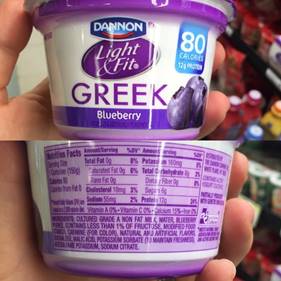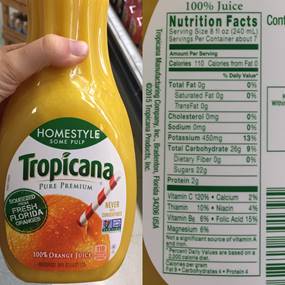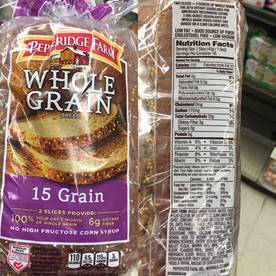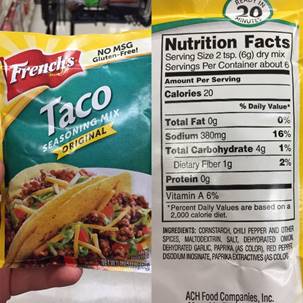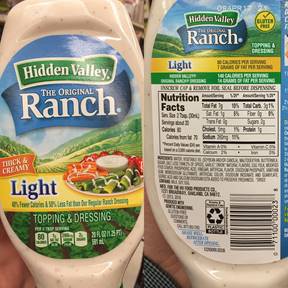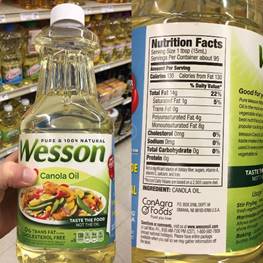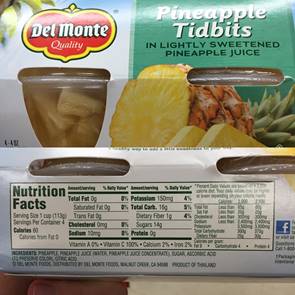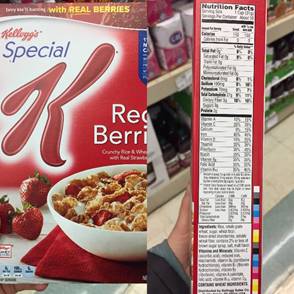 Our bodies are not simple scales balancing calories in and calories out. It has many complex chemical systems that process each ingredient in different ways. Because of this, eating a low-calorie diet is not the best approach to losing weight.
Our bodies are not simple scales balancing calories in and calories out. It has many complex chemical systems that process each ingredient in different ways. Because of this, eating a low-calorie diet is not the best approach to losing weight.
Buzzwords like low-fat, heart-healthy, all-natural, vegan, and gluten-free make us believe that foods are good for us. However, Starbursts are low in fat; Oreos are vegan; and Reese's peanut butter cups are gluten-free. We can't trust claims on labels.
We must look directly at the ingredients. Typically, a shorter ingredient list with words you understand is best. My rule is: "If I wouldn’t want to eat the ingredients plain, then I don't want to eat them all combined in a food-like product." My main concern is my health.
Let's explore ten foods that food manufacturers tricked me into thinking were healthy and how eating real food is more important than counting calories. (Note: I am not picking on the brands below. It's the type of products that concern me.)
Foods I Thought Were Healthy
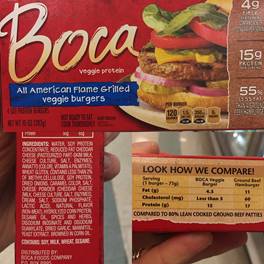 1. Boca Burgers and Veggie Burgers
1. Boca Burgers and Veggie Burgers
Soy patties have less fat and cholesterol than a beef burger, so I thought they were healthier. Now, I am confident that grass-fed burgers are a much better choice.
We need healthy fats and protein. Since the cholesterol in food does not play a substantial role in determining the body’s cholesterol levels, we don't need to be afraid of red meat.
Soy patties also have a long ingredient list with fillers. Grass-fed burgers from a healthy cow that walked around and ate its natural diet while alive are made from only one ingredient: beef. It is nutrient-dense and makes an excellent choice.
2. Fruit-flavored yogurt
This was my breakfast every morning. I thought it must be healthy since it was only 80 calories. Now, I avoid “naturally and artificially flavored” whenever possible. I get plain yogurt and add berries.
I also prefer to get full-fat yogurt. Milk naturally contains fat, so I want to keep it that way. We need to eat healthy fats to produce hormones. It also helps us feel full, maintain energy, stabilize blood sugar, and help with insulin resistance.
Orange juice was my favorite beverage growing up. Who doesn’t love 26 grams of carbohydrates to start their day?
Unless you are SUPER active, most people will gain weight and struggle with blood sugar control if they have over 150 grams of carbs. With a glass of OJ, you are already 17% there (not including the 30+ grams you might eat in the cereal, bagel, or toast alongside the orange juice).
A typical orange has 11 grams of carbohydrates. The membranes between the segments contain fiber, which fills you up and keeps you more satisfied. This principle is true for all juices, so consider it when you want apple, cranberry, or any other juice.
The way bread is made now is VERY different from traditional methods. Previously, grains were slowly soaked and sprouted, making them easy for our bodies to digest. (This is true for both white and whole wheat bread.)
Companies that make bread in bulk today have found cheaper and quicker methods to make bread. Unfortunately, current practices for making commercial bread wreak havoc on our digestive systems and lead to inflammation.
Traditional bread has flour, water, yeast, salt, and maybe a sweetener or herbs. Store-bought bread today tends to have a long ingredient list. It does not meet the standard of the simple things I want to put into my body.
What is more convenient than seasoning packets? I especially loved them for tacos and fajitas... until I read the ingredients.
Many of these packets have MSG, maltodextrin, or disodium inosinate. The term “natural flavors” likely means gluten, and why is the first ingredient corn starch?
Making your own seasoning blends, without any additives, is easy, cheap, and delicious.
Here is a quick recipe for a good taco/fajita seasoning blend. I make this and keep it with my other spices, so it is easily accessible.
6. Salad Dressing
The food marketers tricked me with this one as well. It must be healthy because it says "light" and "gluten-free," especially since it only has 80 calories, right? Wrong.
Most store-bought and restaurant dressings contain oils that are not ideal. When processed at high temperatures or pressures, fatty acids become unrecognizable to our bodies and cause inflammation.
Fat is necessary, but we need “good fatty acids” from real food sources. Coconuts, olives, avocados, fish, and meat are great options.
7. Oil, Vegetable Oil, & Margarine
My thumb covers it in the picture, but the label says “heart-healthy.” This could not be further from the truth.
Highly processed oils did not exist until the early 1900s. Since then, they have become extremely popular because they are cheap and have a long shelf life. You can find them in salad dressing, bread, crackers, chips, baked goods, and more.
This video explains how these oils lead to inflammatory diseases that are so common in our society (even heart disease and cancer). I avoid these like the plague. Instead, I cook with coconut oil or animal fats like ghee and lard. I also use olive oil at low temperatures, like when making salad dressing.
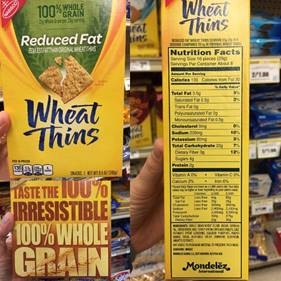 8. Wheat Thins, Pretzels, and Crackers
8. Wheat Thins, Pretzels, and Crackers
Do not let “reduced fat” and “whole grain” trick you. These are not great options.
Any nutrients found in grain can be found in produce. Vegetables are more nutrient-dense and do not contain the extra ingredients and low-quality oils that many of these products do.
These items are also high in carbohydrates. As mentioned in the section about orange juice, most people do not handle high levels of carbohydrates well.
I bought these kinds of packages for lunches because they were so convenient. I thought it must be healthy since it's fruit.
It is fruit, but do you know many (including this one) have added sugar? Why would you add sugar to pineapple? It is already sweet.
Now, I cut pineapple (or other fruit) myself and put it in a container. It is an extra step, but skipping the sugar and added ingredients is worth it.
This contains high levels of carbohydrates, a long list of ingredients, and high vitamin levels. We talked about carbs and a long ingredient list earlier, but why would vitamins be a problem?
By law, wheat flour must be fortified with calcium, iron, and B vitamins (folic acid, thiamin, niacin, and riboflavin). These "fortified” vitamins are artificially added during processing. They are not in the natural forms or ratios Mother Nature intended.
According to this research article, there is some evidence that having TOO HIGH doses of vitamins (from fortification or supplementation) is linked to obesity and diabetes. Our best sources of vitamins and minerals are those naturally found in foods. They will be in the proper ratios and contain co-factors for ideal absorption and utilization.
(My cereal of choice was Special K. There was a challenge that encouraged people to eat only Special K for a week or two to lose weight. Eating good nutrient-dense REAL FOODS like fruits, vegetables, and meats is a healthier way to move towards your ideal weight.
Manufacturers often only focus on their bottom line. They make these products as cheaply as possible using low-quality ingredients designed for a long shelf life. Most corporations also design their food to be addictive by testing combinations of sugar, salt, fat, and chemicals.
However, I want products made with nutrient-dense, high-quality ingredients that will go bad. A long shelf life often means the food is full of chemicals to keep the bacteria away. I also don't want to struggle with craving these low-quality foods. Reading the ingredient list helps me make wise choices about what I put in my body.
Dr. Jamie


